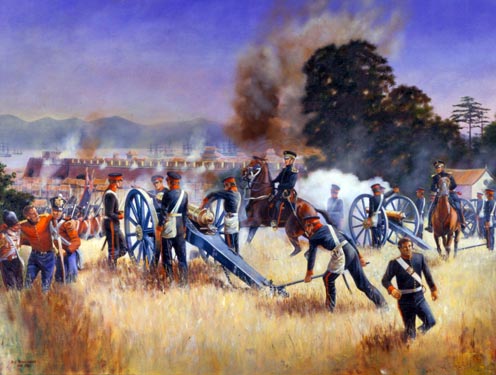« Click on Picture to
Return »
 |
|
The Madras Foot Artillery at the Assault on Chin-kiang-foo, China
21st July 1842: When bad feeling arose over trade relations between the Honourable East India Company and China, an expedition was mounted to re-establish trading facilities in certain Chinese ports. A force of infantry was accompanied by units of the Royal Artillery and Madras Artillery. An amphibious attack was made up-river towards Canton in 1840, and after first taking the forts which defended it, the city itself was eventually captured. After taking Amoy, the British force moved back to establish itself in Canton. Then, the entire British force sailed to capture Shanghai.
Proceeding up the river Yangtse Kiang, the fleet anchored abreast of the city of Chin-kiang-foo, at the foot of whose walls lay the grand canal. On 21st July 1842 all the troops were disembarked and took up their positions. Colonel Montgomerie, who commanded the artillery brigade, placed his guns in a strong position on a low hill commanding the Western gateway and walls. The infantry escaladed the North angle of the walls and after a sharp struggle the city was captured. Hostilities ended when the force reached Nanking.
For operations in the stifling heat and the swampy banks of Eastern rivers, the smaller and handier artillery equipments were preferred. As well as the smaller howitzers, five 6-pounder guns were also used. Field guns of the Madras Artillery had a distinctive flat, circular brass nave plate.
The Madras Artillery regulations describe the Undress uniforms and horse furniture of the officers. They and their men are wearing forage caps. Gunners and drivers with field batteries were armed with short swords. In marching order the Madras Artillery men were ordered to wear Undress jackets, woollen trousers and carry haversacks (containing provisions). As a gun is loaded, one of the detachment goes to fetch another cartridge from the limber in the rear. An officer of the 18th (The Royal Irish) Regiment, suffering (like many) from heat stroke, is aided by one of his soldiers and a sepoy of the Madras Native Infantry.
The China Dragon is an honour which was granted to the units which took part in the campaign.
B Company, 2nd Battalion, Madras Artillery was later absorbed into the British Army.
Medium: Oil on Canvas
Printed image size(s): B2 only (58 x 38 cm)
Owner: 127 (Dragon) Battery Royal Artillery
Price(s): £75
|
|



